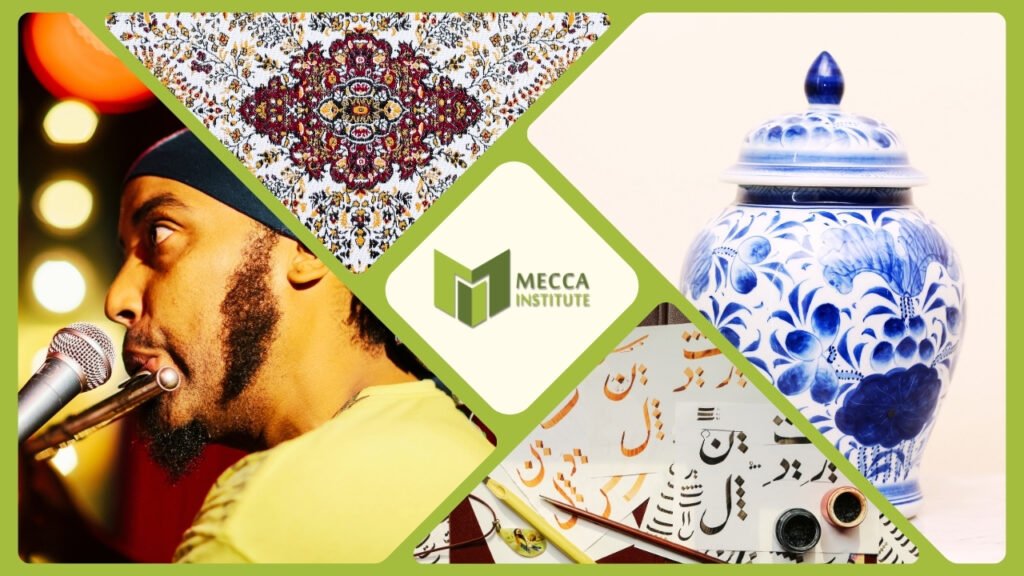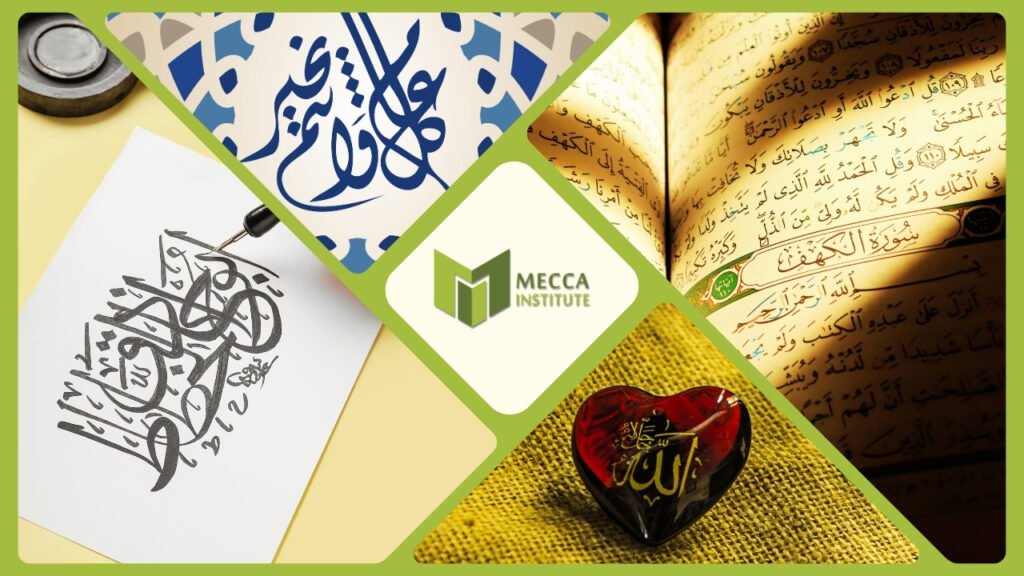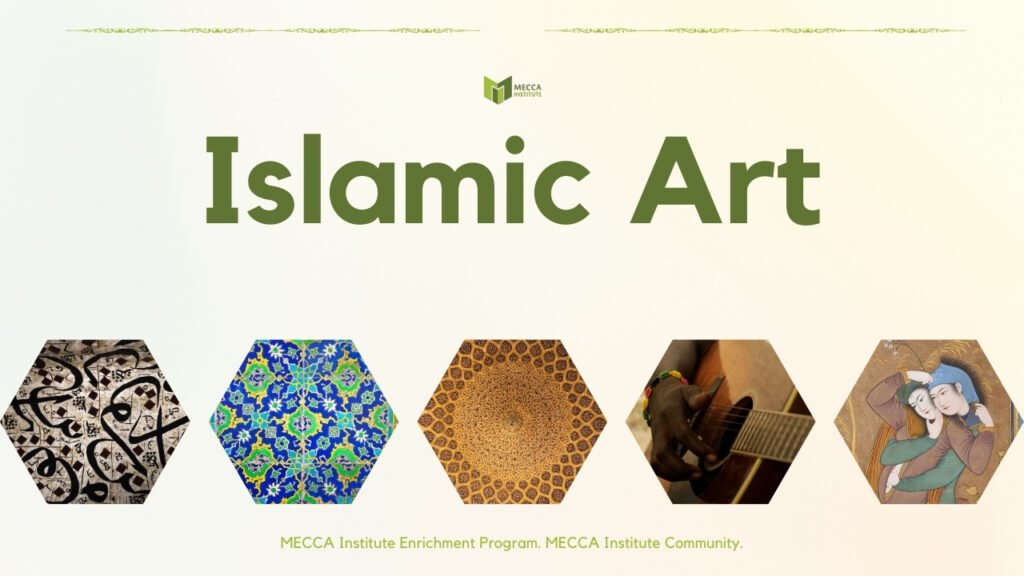Islamic art is diverse, says Imam Daayiee Abdullah, sharing his experiences on the topic from the Muslim World.
The first time I truly experienced Islamic art, I was traveling abroad as a young man in his early 30s from the United States. I had always seen art as paintings or sculptures, but when I saw Islamic art, I realized it was so much more.
I could see it was linked to spirituality.
As I traveled through China, Egypt, and Saudi Arabia, and later other countries, I realized it wasn’t just one style or medium. Islamic art spans visual, literary, and performing arts.
Throughout this guide, I will share with you how diverse this area of Muslim culture is.
Islamic Art History

Islamic Art thrives on a fusion of diverse cultural influences from across the globe, including Sharia Law. From West Africa, lively textile designs influence the art, seen in the bold, colorful textiles of the Sahel region.
In East Africa, the Swahili Coast mixes Arab, Persian, and African aesthetics. This is evident in the unique architecture of Zanzibar, which uses carved wooden doors and gorgeous stucco facades.
The Middle East, as the heart of Islamic civilization, shapes Islamic Art through its refined calligraphy, arabesque designs, and grand mosques. For example, we have seen this in the Alhambra in Spain, a testament to Islamic architecture.
South Asia contributes to Islamic Art through the incredible Mughal miniature paintings and the Taj Mahal’s grandeur. Today, the Taj Mahal is one of the most beautiful architectural pieces in our world.
Even East Asia leaves its mark, with China’s ceramic techniques influencing Islamic pottery.
The Mediterranean, especially in Spain and Sicily, brings Roman and Byzantine artistic traditions into Islamic Art. You will see this in tilework and lavish court art.
In other words, Islamic art owes a lot to the world since the founding of the faith in the 7th Century, although it has since become its own unique styles.
The 3 Types of Islamic Art
Islamic Art is diverse, but it centers around three key elements: calligraphy, islimi, and geometry.
Calligraphy is revered as the highest form of artistic expression in most Muslim cultures. It uses Arabic script to convey divine beauty. The Quranic verses adorn walls, domes, and manuscripts, with examples like the exquisite calligraphy in the Blue Mosque of Istanbul.
Islimi, or arabesque design, features beautiful patterns of interlacing foliage and tendrils. These designs appear in tile work, wood carvings, and textiles.
Geometry plays a central role, with artists creating complex, symmetrical patterns that repsent the infinite nature of the divine. These geometric designs manifest in mosaics, carpets, and architectural details.
So, these elements create a harmonious visual language that transcends the physical world and represents the spiritual realm in Islamic Art. They appear in so many styles of art.
Calligraphy

Islamic Calligraphy has an immense artistic significance in the Muslim world, transcending mere writing to become a moving form of visual art.
Muslims revere the style for its spiritual and aesthetic qualities, as it usually uses verses from the Quran. Calligraphy turns the written word into an expression of divine beauty.
Kufic script dominates early Islamic manuscripts. This style features bold, angular shapes. A great example is the “Blue Qur’an” from Tunisia, known for its gold-inked calligraphy.
Thuluth script has a flowing and ornate quality. It adorns architectural masterpieces like the Blue Mosque in Istanbul, where calligraphy graces its walls and domes.
Of course, the use of calligraphy extends beyond religious texts, influencing everyday objects like ceramics, textiles, and coins.
Meanwhile, the influence of calligraphy reaches beyond the Muslim world—examples like the calligraphic designs in Persian miniature paintings show us its fusion with other art forms.
Therefore, calligraphy’s elegance and spiritual significance make it a cornerstone of Islamic Art, shaping both religious and secular culture across centuries.
Islimi
Islimi, or arabesque, continues to profoundly influence Islamic Art. The style has become a central motif across the Muslim world.
Its intricate, repeating patterns of flowing lines and stylized foliage symbolize the infinite nature of creation, representing divine beauty and harmony. This is a style hard to miss.
Artists use islimi designs extensively in architecture, where they beautify the walls, ceilings, and arches of mosques, palaces, and madrasas.
The Alhambra in Spain is a great example, showing stunning islimi patterns in its tile work and stucco that create a spiritual transcendence.
In Persian carpets, beautiful arabesques flow across the fabric with mesmerizing patterns. As a result, many Muslim cultures put them on the walls as pieces of art.
Islimi also appears in Islamic manuscripts, where it complements calligraphy, strengthening the visual impact of sacred texts.
Of course, islimi’s influence also extends to metalwork, pottery, and textiles, with its motifs appearing on objects like vases and embroidered fabrics.
So, the enduring popularity of islimi illustrates its important role in unifying aesthetic beauty with spiritual meaning across Islamic cultures.
Geometry
Geometry plays a major role in Islamic Art, and it usually represents the infinite nature of the divine and the order of the universe.
Muslim artists use geometric patterns to create complex, symmetrical designs that dominate architecture, textiles, and manuscripts.
Islamic architecture features stunning geometric tile work that focuses on harmony and precision.
In mosques, geometric patterns appear on floors, ceilings, and walls as a way to create unity and spiritual elevation.
Of course, mosaic tiles in places showcase geometric shapes, often combined with arabesques and calligraphy, to produce a rich visual effect.
Meanwhile, Islamic carpets also display geometric patterns, with their repeating motifs symbolizing infinity in most cases.
Geometric design extends into everyday objects, such as metalwork and ceramics, where it transforms functional items into visually striking pieces.
So, through its precision and endless repetition, geometry is way to create a bridge between the material world and the divine in Islamic Art.
Islamic Music

Islamic music has is another art form that has profound influence across the Muslim world. This art form presents both spiritual and cultural expressions.
Tajweed is probably the most common in religious context. This is the art of reciting the Quran with precise phonetic and melodic rules.
While not music in the conventional sense, Tajweed shares many musical qualities. It uses rhythm, tone, and intonation to enhance the spiritual experience of listening to the Quran.
Famous Tajweed masters like the Egyptian Al-Hussary, who died in 1980, outsell pop musicians, even long after they are dead.
Another unique aspect of Islamic music is Nasheed. This is a form of devotional music that features vocal harmonies and rhythmic beats, often praising God and the Prophet Muhammad. It plays a key role in religious events and celebrations.
Of course, there is also Maqamat. This is the system of melodic modes, which underpins much of Islamic classical music in regions like the Middle East and Central Asia.
Meanwhile, in South Asia, Qawwali fuses rhythmic energy with spiritual lyrics. Its popularity comes from artists like Nusrat Fateh Ali Khan. Instruments like the oud and darbuka further enrich the musical tradition.
Therefore, Islamic art is uniting sound and spirituality across the Muslim world.
Islamic Paintings
Islamic paintings are another incredibly diverse form of art in Muslim cultures. It presents regional and cultural variations.
For example, in West Africa, Islamic art mixes local traditions with Islamic influences. One great example is the lively Timbuktu Manuscripts from Mali, where complex geometric patterns and figures adorn pages.
North African paintings, particularly from Morocco, tend to focus on beautiful miniature scenes. These scenes usually depict daily life and historical events, using bold, striking colors.
In Arabia, Islamic paintings focus on calligraphy, where Qur’anic verses mix with decorative elements.
And, kin Persia, paintings illustrate royal courts, battles, and mythology. These paintings present fine details and bold colors, exemplified in works from the Shahnameh.
Meanwhile, Ottoman art mixes Persian influence with local styles, creating paintings that depict courtly life and the natural world. They appear widely in the Süleymaniye Library manuscripts.
Of course, Mughal paintings are also worthy to note. They mix Indian and Persian techniques, focusing on detailed portraits and grand landscapes. For example, the Akbarnama shows us a lot of these.
Also, Central Asian Islamic paintings are important. They present beautiful book illustrations and decorative designs, influenced by the Silk Road.
So, each region’s unique style presents the wide-ranging diversity of Islamic painting.
Famous Islamic Art
Famous art pieces from the Muslim world show us the brilliance and diversity of Islamic Art.
The Dome of the Rock in Jerusalem is without a doubt a masterpiece of Islamic architecture. Although its popularity stems from the fact that it’s the third holiest site in Islam, no one can deny the beautiful mosaics and geometric tile work are a feast for sore eyes.
Another great one is the Alhambra in Spain. This is extremely popular because of its exquisite stucco arabesques and detailed calligraphy. It presents the splendor of Islamic craftsmanship of its era.
Of course, the Blue Qur’an from Tunisia is something incredible. It features gold Kufic calligraphy on indigo-dyed parchment. By far on the most stunning examples of early Islamic manuscript art.
Meanwhile, leaving out the Taj Mahal would be a disservice. This landmark features symmetrical design and marble inlays, and it truly remains an incredible symbol of Mughal architecture.
Therefore, each of these works exemplifies the fusion of spiritual, geometric, and artistic elements that define Islamic Art.
Islamic Art Photos
To explore Islamic Art through photos, several online platforms give you access to a wealth of visual resources.
Google Images is an accessible way to find a wide variety of Islamic art, from architectural masterpieces to intricate miniatures.
For a more scholarly approach, museum websites such as the Metropolitan Museum of Art and the British Museum host digital collections with high-quality images of Islamic artifacts. You will see calligraphy, geometry, and islimi designs.
Meanwhile, the Arab Image Foundation has archive of photographs and documents that show Islamic art and culture.
Of course, social media platforms, especially Pinterest and Instagram, give users the opportunity to explore curated boards or hashtags like #IslamicArt. They are great places for a continuous flow of images from both historical and contemporary sources.
Conclusion
Islamic art mixes calligraphy, geometric patterns, and arabesques that present spiritual and cultural diversity across regions. What is undeniable about Islamic art is its focus on beauty, symmetry, and divine unity.
If you get the chance to travel, visit some of the places mentioned here.
May Allah continue to guide us all.
Imam Daayiee Abdullah is the Executive Director of MECCA Institute and the author of “Progressive Islam,” a historic book that defines Progressive Islam.

